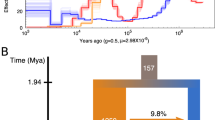Abstract
In the Canary Islands two invasive rat species, Rattus rattus and Rattus norvegicus are present, but little is known about the origin and colonization. To this end, a molecular study was performed on R. rattus from the Archipelago and from the nearest continents. Partial cytochrome b gene sequencing offered very low levels of haplotype and nucleotide diversities, with only seven haplotypes identified. All of them belong to the European Lineage I, specifically to the “ship rat” cluster. The haplotype network showed a star-like topology. Haplotype distribution showed a genetic subdivision between eastern and central/western islands, suggesting a double colonization event. This hypothesis is congruent with historical human colonization and it is similar to that proposed for the rodent parasite Hymenolepis diminuta. In addition, a possible role of the Canary Islands as a faunal link with the European and American continents is discussed.



Similar content being viewed by others
References
Acosta V (1993) Emigración clandestina de El Hierro a Venezuela. CCPC, Santa Cruz de Tenerife
Aplin KP, Suzuki H, Chinen AA, Chesser RT, ten Have J et al (2011) Multiple geographic origins of commensalism and complex dispersal history of Black Rats. PLoS ONE 6(11):e26357. doi:10.1371/journal.pone.0026357
Bastos AD, Nair D, Taylor PJ et al (2011) Genetic monitoring detects an overlooked cryptic species and reveals the diversity and distribution of three invasive Rattus congeners in South Africa. BMC Genet 12:26
Bethell L (1984) The Cambridge history of Latin America Vol 2: colonial Latin America. University Press, Cambridge
Drake DR, Hunt TL (2009) Invasive rodents on islands: integrating historical and contemporary ecology. Biol Invasions 11:1483–1487
Flores C, Maca-Meyer N, Pérez JA, González AM, Larruga JM, Cabrera VM (2003) A predominant European ancestry of paternal lineages from Canary Islanders. Ann Hum Genet 67:138–152
Foronda P, López-González M, Hernández M, Haukisalmi V, Feliu C (2011) Distribution and genetic variation of hymenolepidid cestodes in murid rodents on the Canary Islands (Spain). Parasit Vector 4:185–194
Fregel R, Gomes V, Gusmão L, González AM, Cabrera VM, Amorim A, Larruga JM (2009) Demographic history of Canary Islands male gene-pool: replacement of native lineages by European. BMC Evol Biol 9:181
González Antón J (2005) Fuentes hemerográficas para el conocimiento de la emigración clandestina en velero de Canarias a Venezuela a mediados del siglo XX. Anu Am Eur 3:291–314
Hingston M, Goodman SM, Ganzhorn JU, Sommer S (2005) Reconstruction of the colonization of southern Madagascar by introduced Rattus rattus. J Biogeogr 32:1549–1559
Martin Y, Gerlach G, Schlötterer C, Meyer A (2000) Molecular phylogeny of European muroid rodents based on complete cytochrome b sequences. Mol Phylogenet Evol 16:37–47
Nogales M, Rodríguez-Luengo JL, Marrero P (2006) Ecological effects and distribution of invasive non-native mammals on the Canary Islands. Mammal Rev 36:49–65
Onrubia-Pintado J (1987) Les cultures préhistoriques des Îles Canaries, état de la question. L’Anthropologie 91:653–678
Rando JC, Cabrera VM, Larruga JM, Hernández M, González AM, Pinto F, Bandelt HJ (1999) Phylogeographic patterns of mtDNA reflecting the colonization of the Canary Islands. Ann Hum Genet 63:413–428
Rando JC, Alcover JA, Michaux J, Hutterer R, Navarro JF (2011) Late-Holocene asynchronous extinction of endemic mammals on the eastern Canary Islands. Holocene. doi:10.1177/0959683611430414
Russell JC, Gleeson DM, Le Corre M (2011) The origin of Rattus rattus on the Îles Éparses, Western Indian Ocean. J Biogeogr 38:1834–1839
Tollenaere C, Brouat C, Duplantier J-M et al (2010) Phylogeography of the introduced species Rattus rattus in the western Indian Ocean, with special emphasis on the colonization history of Madagascar. J Biogeogr 37:398–410
Towns DR, Atkinson IAE, Daugherty CH (2006) Have the harmful effects of introduced rats on islands been exaggerated? Biol Invasions 8:863–891
Viera Y Clavijo, J (1772) Historia de la Islas Canarias. Vol 1. Cupsa, Madrid
Acknowledgments
We are grateful to people who supplied us with samples: J. Miquel (Senegal and Tunisia), C. Cutillas (Spain), R. Fons (France), R. Libois (Benim) and V. Haukisalmi (Finland). The final version of the manuscript was improved by comments from V. Haukisalmi and V. Hernández. This paper was supported by National projects CGL 2006-04937 and CGL 2009-07759BOS, and the project 2009 SGR 403 financed by “La Generalitat de Catalunya”. Animal trapping and use was approved by the Governmental “Exmos Cabildos Insulares”.
Author information
Authors and Affiliations
Corresponding author
Rights and permissions
About this article
Cite this article
López, M., Foronda, P., Feliu, C. et al. Genetic characterization of black rat (Rattus rattus) of the Canary Islands: origin and colonization. Biol Invasions 15, 2367–2372 (2013). https://doi.org/10.1007/s10530-013-0466-3
Received:
Accepted:
Published:
Issue Date:
DOI: https://doi.org/10.1007/s10530-013-0466-3




